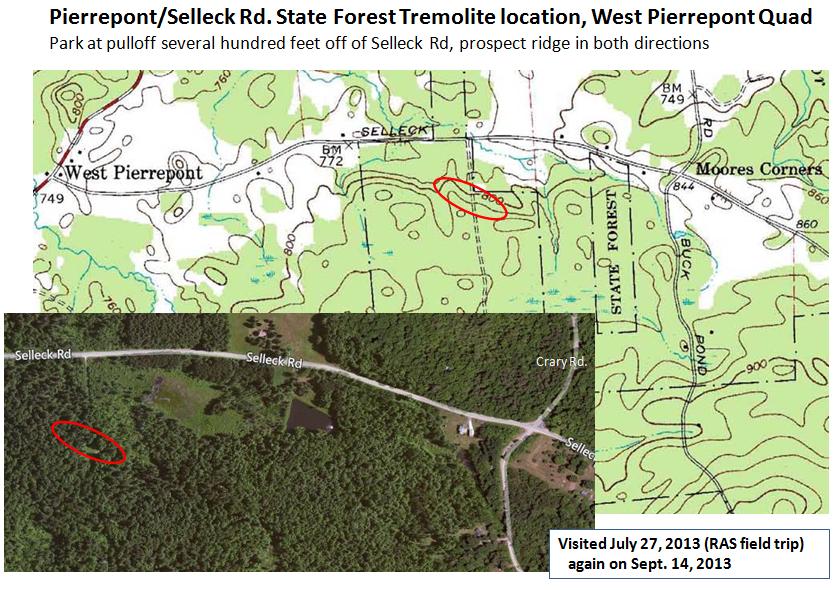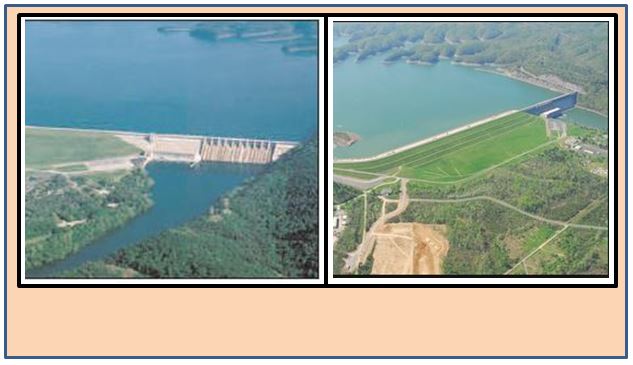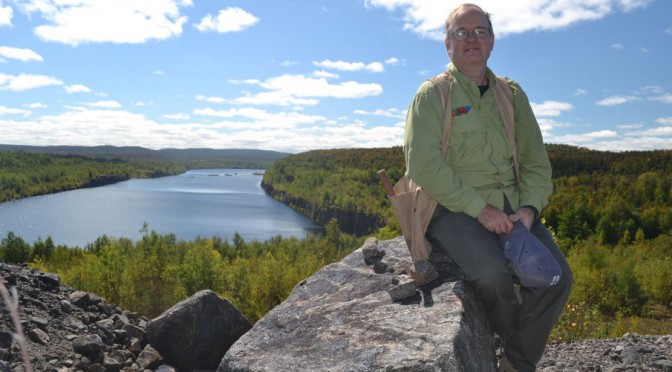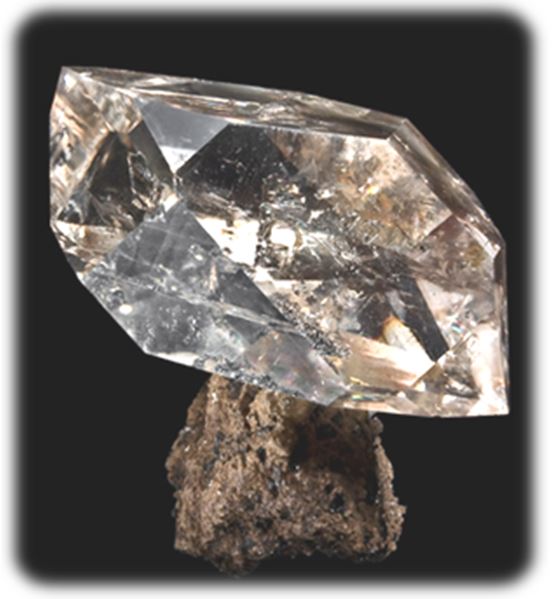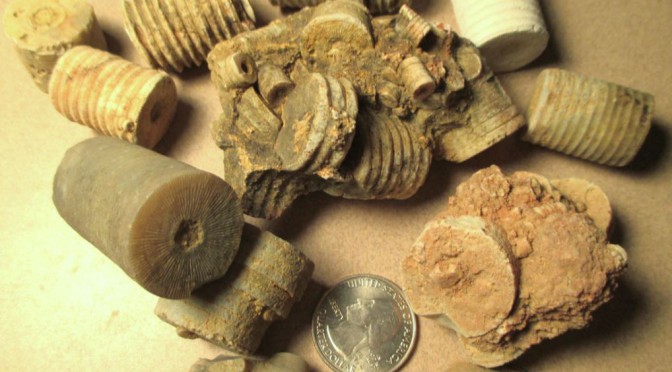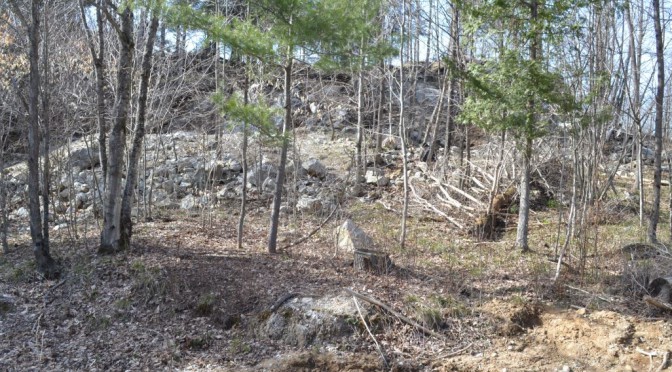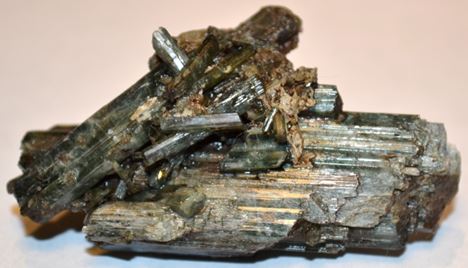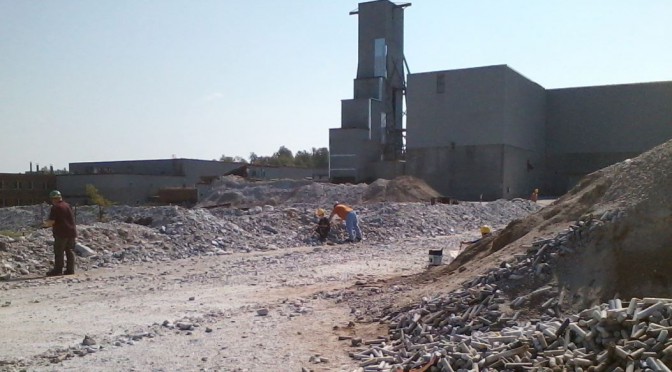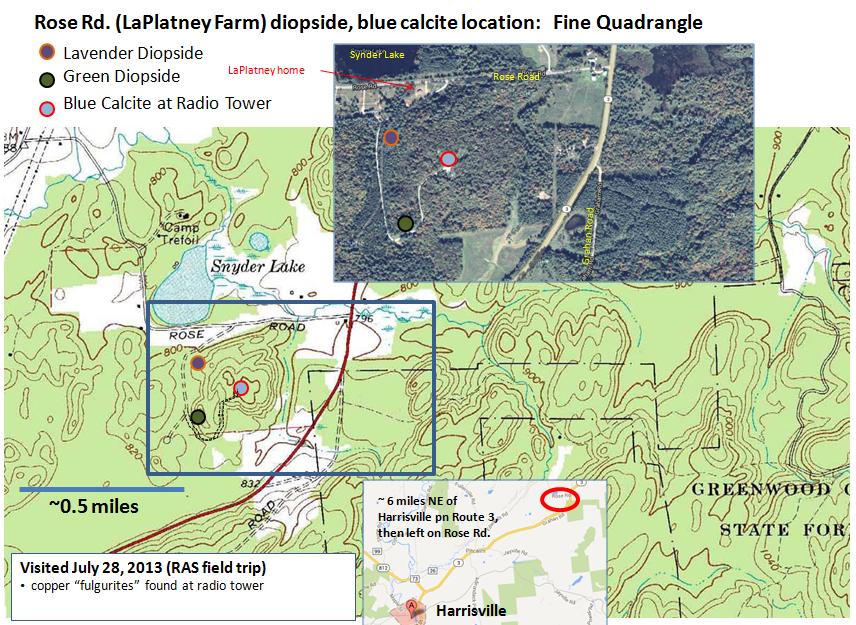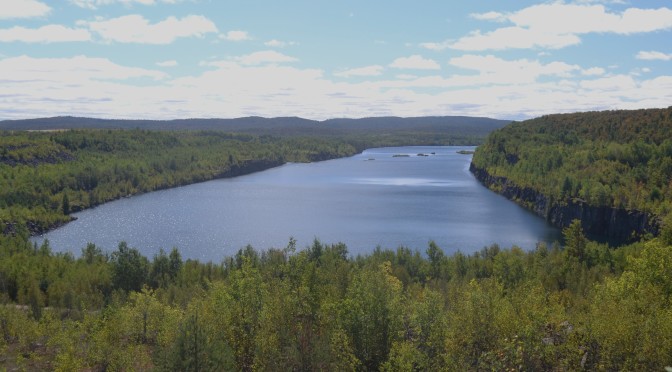Occupying an east-west ridge just south and parallel to Selleck Road in West Pierrepont this location has been collected for decades. The main part of the ridge is on state land and accessible without much walking, thereby adding to the popularity of the site. Tremolite is everywhere, tourmaline (v. uvite) is much more localized along the ridge. Both the light green tremolite and the uvite is typically etched and non-gemmy, however isolated pockets of very gemmy material has been found.
Wolf Creek Dam, Kentucky
Geology in Action, Wolf Creek Dam, Lake Cumberland, Kentucky
The construction of Wolf Creek Dam in central Kentucky began in 1941, but work was interrupted by WW2 and the dam was not completed until 1951. Potential problems with the integrity of the underlying Ordovician Leipers limestone were appreciated during construction and extensive cement was placed in a number of cave features that were known to exist before the earthen dam was built above. However, that early work proved to be insufficient in preventing seepage from Lake Cumberland through the underlying karst.
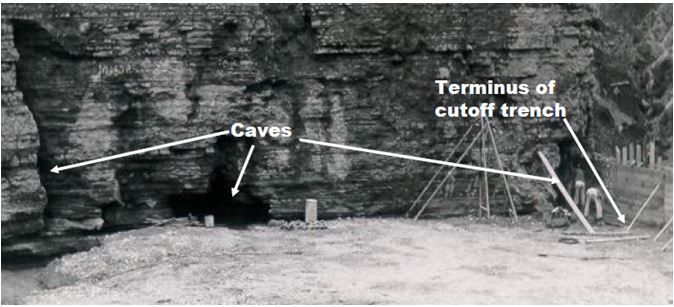 1947 photograph highlighting cavernous regions in the dam’s base that were filled with cement.
1947 photograph highlighting cavernous regions in the dam’s base that were filled with cement.
Benson Mines, Star Lake, NY
Have you driven Route 3 in southern St. Lawrence County? Did you know that as you pass just east of the small hamlet of Star Lake you are just hundreds of feet south of what was once the largest open pit iron mine in the world? That’s right, in 1958, during the height of its life, the Benson Mines open pit iron mine held that lofty title. The pit was 4 kilometers long, 250 meters across and 400-600’ deep. Today the pit is host to a whole lot of brilliant blue water and the surrounding Adirondack Park region is forest covered and virtually pristine wilderness.
The high concentration of iron in the rocks of the region was first recognized in 1810 when engineers surveying for a military road found their compasses wandering. But until the timber industry built a railroad to the region the iron ore could not be exploited. Even with rail, the area was still remote and from 1890 to 1940 mining was sporadic and limited. In 1941, Jones and Laughlin Steel Company leased the properties and constructed plant facilities. Continue reading Benson Mines, Star Lake, NY
Happy New Year
Mineral Musings in the January, 2014 WCGMC News:
Happy New Year:
Has everyone made their New Year’s Resolutions? You know, the one’s you keep until you can’t anymore. Here are mine:
1) I resolve to attend as many rock, mineral, and fossil collecting trips with WCGMC as possible (that should be easy to keep).
2. I resolve to clean up, organize, and label specimens from each trip before the next trip (now that would be a first for me).
3. I resolve to lose 15 pounds during next year’s gardening and collecting season (I manage to do this most years).
4. I resolve not to gain those pounds back during the hibernating/eating season that follows the summer (trouble is I fail this every year such that resolution #3 becomes necessary every year).
Maybe we should share resolutions at an upcoming club meeting? Or the next time we are in the field.
Our fearless trip leader, Bill Chapman, tells us that one early trip will be April 1 with a visit to Ace of Diamonds in Herkimer. I guess that is as fitting a day as any for folks with our hobby to be “hunting diamonds.” Most of you are well acquainted with digging in the Cambrian dolostones of Herkimer County. For me this will be a new treat. I have been there once, but decades ago and only briefly. I’ll be looking for a few 3 inch crystals on matrix that look like this !
Collecting in Tennessee
An article I wrote for January, 2014 WCGMC News (www.wcgmc.org)
In mid-November, 2013 Wayne County Gem and Mineral Club member Linda Schmidtgall and her husband Les made one last collecting trip before winter. And they were smart: they pointed their fossil hauling Chevy pickup south and travelled to north central Tennessee to hook up with the Knoxville Gem and Mineral Society and the Georgia Mineral Society on their annual fall crinoid and coral “harvest”. Fossil hunting along the shorelines of the Tennessee and Kentucky lakes is best when the water level is lowest in late fall and crinoid fossil remnants can be collected by the bucket full. Stem sections, or cemented crinoidal hash locally referred to as crinoidal plates, can be collected along the shoreline or just below the water line. All are fully silicified into grey or light bluish chalcedonic chert.
Minerals on Stamps
On November 14, 2013 I presented a program simply entitled “Minerals on Stamps” to the Rochester Philatelic Association. As a retired geologist, collecting minerals and other geology related topical stamps is a natural merger of my collecting interests.
Did you know that the checklist of gems and minerals on stamps maintained by the Gems and Minerals Study Unit of the American Topical Association has over 3000 entries? Or that all 8 of the US mineral stamps depict specimens that reside in the Smithsonian? The FDC with the four 10 cent stamps issued in 1974 is depicted shown below. The mineral specimen in the bottom stamp is affectionately referred to as “The Postage Stamp Tourmaline.” It is from the pegmatite mines outside San Diego, CA.
Rose Road, Pitcairn, NY
An article I wrote for the WCGMC News in December, 2013
One of the more popular mineral locations for upstate New York rockhounds this year was Rose Road off Route 3 in Pitcairn, a daily fee site owned by Mr. Richard LaPlatney who lives at the property. Although the silicate skarn mineralization flanking the Grenville age white marble hill has been visited by mineral collectors dating back to 1880’s the location seems to have been rejuvenated after Walter highlighted the mineralogy and collecting history in his 2007 book “Field Collecting Minerals in the Empire State”.
The major “digging” there this year was focused on the first site encountered after passing LaPlatney’s home just off of Rose Road. At first glance the exposed rock seems to be dominated by lavender diopside, calcite, albite and red brown phlogopite.. A Scanning Electron Microscopy/Energy Dispersive Analysis (SEM/EDA) of the lavender diopside indicated elevated Ti, likely substituting into the Mg spot in the lattice to generate the lavender color (S. Chamberlain, pers. comm.). There is also less Fe in the purple diopside than in the green version found just a few hundred feet farther up the road.
A New Tremolite Location in Canton, NY
A friendly local mineral collector shared a new site with Dick and Jeanne Phillips and Fred Haynes during the St. Lawrence County show in Madrid, NY in August. Apparently, Wildwood Road east of Colton, NY was not draining well and the county decided to level the ground on both sides of the road to improve runoff. In doing so they exposed bright white marble outcrops that were cut by zones of orange calcite, light green serpentinite and green tremolite. And right on the road !

Two St. Lawrence County Sites
On Tuesday August 20th, nine RAS members met outside St. Lawrence Zinc’s famous #4 mine in Balmat, NY. The party included Gary Mosbruger (who was helpful in setting up the visit), his sons Alan and Bryan, John Klahn with his sons Anthony and Ryan, Jerry Curcio, Paul Dudley and me. Once at the mine location, we were met by Bill deLorraine, Senior Geologist for the mine and also the President of the St. Lawrence County Rock and Mineral Club.
Bill led us upstairs for a safety briefing and to view some of the large fine mineral and ore specimens that have been recovered from the lower levels of the mine. Then he turned us loose on the ore piles and drill core pieces that were conveniently stacked adjacent to the main shaft. We were able to collect what we could carry. Much of the ore was massive to near massive red-brown sphalerite, often speckled with small disseminated pyrite cubes. Elsewhere the sphalerite swirls through the host marble as jelly in a jelly roll. Unfortunately the nature of the occurrence does not lend itself to crystalline ZnS, but cleavage faces sure reflect sunlight making for pretty rock specimens. Sphalerite is soft (hardness of 3.5), so cabochons and other polished surfaces do not make good durable jewelry pieces, but they can be most decorative.
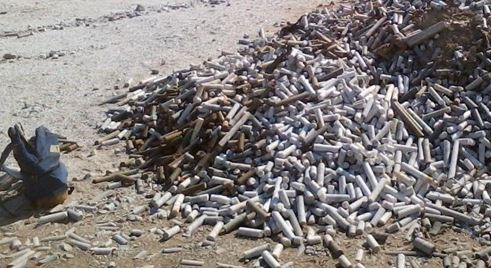
I have not done much with the drill core I packed out, but I did make sure to recover a little of all available rock types. In addition to the red-brown sphalerite swirling through the white marble, pure white marble, light-green serpentinite (often spotted in marble), and orange calcite were all represented in the core.. In addition some of the metasediments (now schists and gneisses) are pretty in their own right when captured in a 1 3/8th inch diameter core.
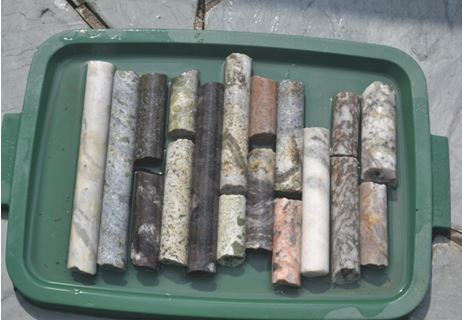
We left Balmat a little after noon and headed over to Rose Road off Route 3 in Pitcairn. Everyone was intent on finding that elusive big sky blue apatite together with the pretty lavender diopside at the northern most digging on the property. We did find some, but recovery was not easy and most were small.
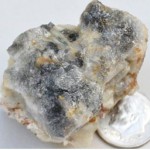
Paul speculated that this mineral might be scapolite at the outcrop, but we were less certain once back in Rochester as scapolite was not in the previously published mineral list for the property. I sent a picture to Steve Chamberlain given the locality was included in his recent book. Steve responded promptly telling us that significant scapolite had been recovered at the site this season and that our samples were definitely scapolite (~ 50% each end member Na-rich marialite and Ca-rich meionite by SEM/EDA). He sent this picture of one of his specimens.
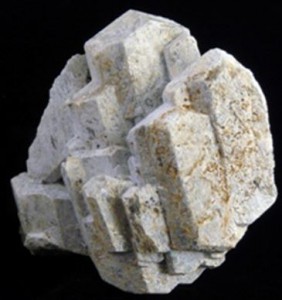
An SEM/EDA analysis of the lavender diopside indicated elevated Ti, likely substituting into the Mg spot in the lattice and likely affecting the lavender color (S. Chamberlain, pers. comm.). There is also less Fe in the purple diopside than in the green version just a few hundred feet up the road.
We continued to that second site and collected green diopside with albite and occasional chocolate brown titanite.. I particularly like the samples with bright white crystalline albite intergrown with the diopside. And naturally, everyone took their fill of blue calcite from the boulders that line the road to the radio tower.

Before leaving, Paul and I explored a bit behind the radio tower atop the marble hill and believe we discovered a previously unknown mineralized outcrop. Everything was covered by moss and lichen, but I took a couple pieces home and applied bleach. The result showed orange calcite, green diopside and white albite. Strongly etched on this surface sample, but perhaps a new site to dig come spring ?

Before leaving, Paul and I explored a bit behind the radio tower atop the marble hill and believe we discovered a previously unknown mineralized outcrop. Everything was covered by moss and lichen, but I took a couple pieces home and applied bleach. The result showed orange calcite, green diopside and white albite. Strongly etched on this surface sample, but perhaps a new site to dig come spring ?
Owen Prospect, Pierrepont, NY
Unlike many St. Lawrence County locations, the Owen Prospect off Irish Settlement Road in Pierrepont is a newly discovered site. But like many others, the mineralization here is scattered and geologically diverse. Exposed outcrops of marble are cut by silicate bearing assemblages. As the silicates are a bit “softer” it appears that the best collecting process may involve finding some loose weathered out mineralization in the dirt and digging down to bedrock. The few locations that have yielded nice specimens to date do not appear to have been found from outcrop.
Rose Road, Pitcairn, NY
Benson Mines, Star Lake, NY
September 14, 2013: I met up with the St. Lawrence Mineral Club and the SUNY-Plattsburgh Geology Club for an interesting visit to Benson Mines in Star Lake, NY. Approximately 12 members of the St. Lawrence Club and 15 undergraduates from Plattsburgh were guided through the property by the current caretaker of the property, George Peerson.
Benson Mines was an open pit iron mine that exploited a magnetite-martite rich unit in the high-grade metamorphic terrain of the Appalachian Lowlands. The pit is not a beautiful tree-lined lake just north of the town of Star Lake on Route 3.
New York Mineral Collecting
New York is rich in mineral collecting sites. Many have been known for hundreds of years, but others are being found every year.
The purpose of this site is to capture personal knowledge of sites I have visited, and others that I would like to visit. This input includes maps, field pictures, mineral photos, and literature references. It is not meant to be complete in any category, and I intend to continually add to the site as I explore New York geology and minerals.
